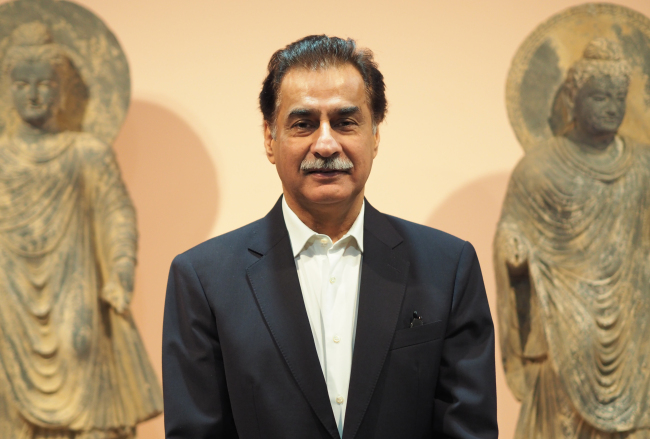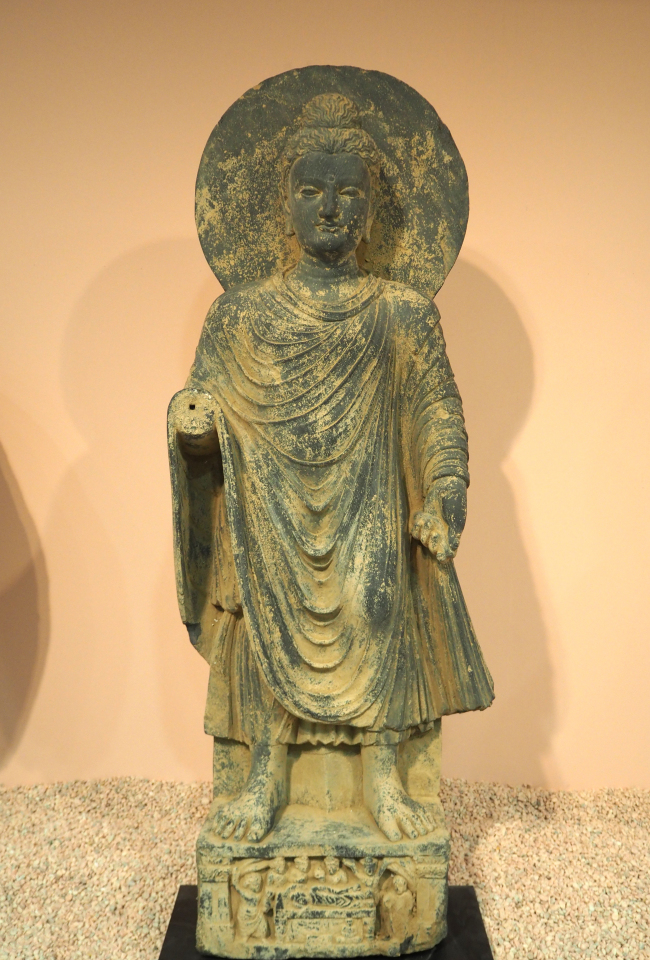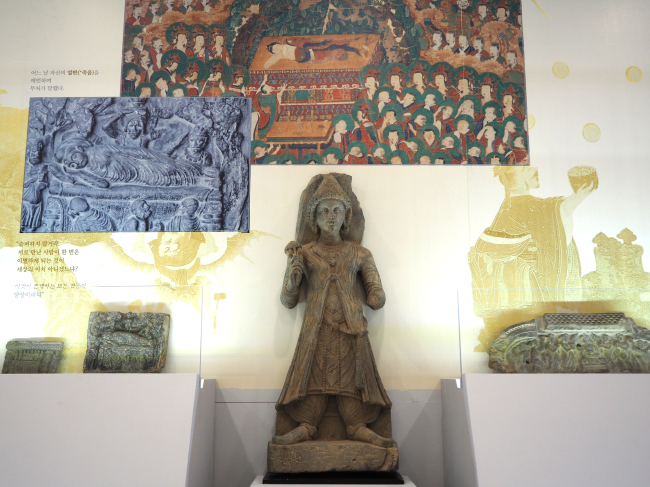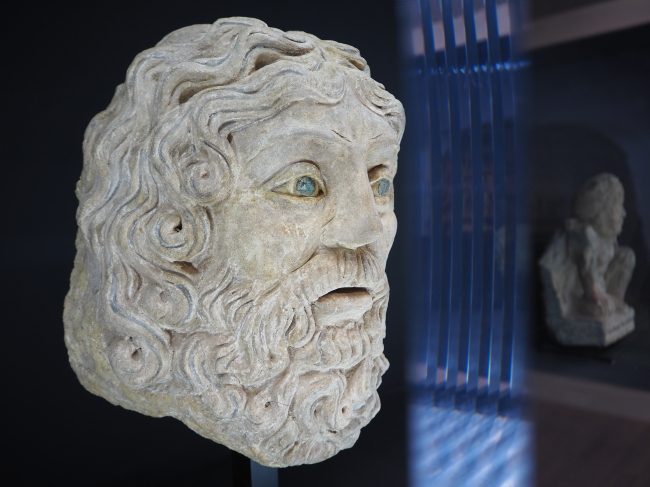In the eyes of Sardar Ayaz Sadiq, speaker of the Pakistani National Assembly, the exhibition “Alexander the Great meets Buddha” at Seoul Arts Center is demonstrable evidence of the enduring linkages between Pakistan and Korea that were spawned more than 16 centuries ago.
A collaboration with the Peshawar Museum and Lahore Museum, the exhibit began Thursday and runs through Sept. 30, showcasing Buddhist sculptures of the Gandhara Civilization that thrived in territories of today’s northwestern Pakistan and northeastern Afghanistan some two millennia before.
“This exhibition and all the artefacts presented here from Pakistan brings a message of globalization that took place in 384 AD when monk Maranatha from the city of Swabi visited Korea,” the parliamentarian told The Korea Herald last week. “He spread Buddhism to Korea as well as other parts of the region, which still endures to this day. Pakistan offers many more treasures of Buddhism, including the actual places Buddha stayed and lived in.”
The region also has picturesque, unadulterated mountains, valleys and glaciers for outdoors-loving adventurers and travelers, according to Sadiq.
A collaboration with the Peshawar Museum and Lahore Museum, the exhibit began Thursday and runs through Sept. 30, showcasing Buddhist sculptures of the Gandhara Civilization that thrived in territories of today’s northwestern Pakistan and northeastern Afghanistan some two millennia before.
“This exhibition and all the artefacts presented here from Pakistan brings a message of globalization that took place in 384 AD when monk Maranatha from the city of Swabi visited Korea,” the parliamentarian told The Korea Herald last week. “He spread Buddhism to Korea as well as other parts of the region, which still endures to this day. Pakistan offers many more treasures of Buddhism, including the actual places Buddha stayed and lived in.”
The region also has picturesque, unadulterated mountains, valleys and glaciers for outdoors-loving adventurers and travelers, according to Sadiq.

Sadiq came to Korea to participate in the Meeting of Speakers of Eurasian Countries’ Parliaments that ended Wednesday. The annual conference designed to enhance cooperation between Eurasian politicians and governments was jointly hosted by the Korean parliament and the State Duma, the lower house of Russian legislature. It brought together parliamentary leaders from 25 Asian and European countries as the second congregation after the maiden convention in Russia last year.
“The relationships between our countries are taking a new dimension,” the politician said, noting that the number of participating countries increased substantially and many countries are showing their interest in joining. The key issue discussed was enhancing connectivity across Eurasia, alongside trade and investment, energy, counterterrorism and food security, among others.
“All participating parliamentarians confirmed their serious intentions to cooperate and shared their views on how to move forward our partnerships. It is an ongoing work and we will continue to make improvements,” he said.
Korea is an ideal partner and role model for any developing country, he enunciated, noting it is envied worldwide for its advances in economic development, democracy and human rights, cultural promotion and fight against climate change. “As Korea constantly prepares for the future, Korea can be a guiding force for developing countries on various fronts, particularly on the technology side.”

Eurasia can benefit by collaborating with Korea, he underscored, adding Korea can be a major player in Eurasia’s Far East by leveraging its brand power, technology and capital. When free trade and infrastructure connectivity materialize across Eurasia, they will benefit both Korean and Eurasian economies, he forecast.
Sadiq encouraged Korean investment in Pakistan, as the country is bolstering its physical connectivity through the China-Pakistan Economic Corridor, a collection of infrastructure projects currently underway to link western China and Pakistan. The $62 billion is part and parcel of Beijing’s ambitious “One Belt, One Road” initiative, a 65-nation geostrategic project that aims to create a modern Silk Road connecting China, Central Asia, Europe and Africa.
Korean companies can be part of the CPEC and OBOR, which offer the fastest and shortest route to markets in Afghanistan, Iran, China and Central Asian countries, he highlighted. The Gwadar Port in southwestern Pakistan is a crucial link between OBOR and its constituent Maritime Silk Road projects, and can be a prime entry point for goods shipped from Korea through the sea to enter the Eurasian economies, he argued.
Sadiq particularly encouraged Korean companies’ relocation to Pakistan to take advantage of its cheap labor, averaging a monthly wage of $150, compared to Korea’s over $2,000.


“Opportunities and margins of profit are much greater in developing countries compared to developed countries,” he stressed. “Korean companies can produce and sell for local consumption in Pakistan, with over 200 million people including growing middle classes, as well as export to Iran, Afghanistan, China and Central Asian countries. This is the most opportune source of cooperation for both economies.”
Pakistan’s Special Economic Zones provide zero customs duty of sales tax on imported machinery and a tax holiday of 10 years for revenue. The infrastructure is in place and the zones are gearing up to start production before 2020. He advised investing in hydropower, railways and roads, as well as information and communication technology, mentioning the Seoul-sponsored Information Technology Park in Islamabad -- modeled after Pangyo Techno Valley in Seongnam, Gyeonggi Province -- that will be built through the $500 million Economic Development Cooperation Fund.
Turning back to culture, Sadiq said that Pakistan is a “traditional” society, and therefore cultural cooperation with Korea can be more successful along the line of traditional culture and heritage.
“Pop cultures come and go” like fleeting winds fickle to flimsy whims, he explained, “But what stays are history and tradition.” In the eyes of Pakistanis, he said, traditional Korean costumes, or hanbok, are more “beautiful” and preferable to revealing clothes worn by K-pop artists.

Kim Yang-soo of cultural advisory services firm Interart Channel, who curated the exhibition, said the venue aims to be a moral guide for the world divided and fractured along hegemonic power struggles, by displaying sculptures that were birthed through the merging of Oriental and Occidental civilizations.
“The Gandhara artefacts themselves are living proofs of reconciliation,” Kim said, citing carved artworks portraying Greek mythological hero Hercules as one of the Four Heavenly Kings of Buddhism. Kim is currently working to produce a hologram of the fasting Buddha sculpture, which he plans to showcase across renowned museums around the globe.
Professor Park Kyo-soon, who taught at Fatima Jinnah Women University in Pakistan, said the event would help viewers harness a better understanding of one important strand of Korea’s cultural origins that traces its roots to Pakistan.

“While the Western art largely comes from Christianity, the Asian art originates from Buddhism,” she said. “And Buddhist art sprang from Gandhara. As our modern thinking is overly dominated by Western values and cultures, we need to develop a more balanced and holistic understanding of our origins. That will lead to a new historic insight.”
Kim, who is making efforts to revive the world’s very first university in Taxila, Pakistan, through Korean support, asserted that Korea can reap dividends by investing in cultural ties with Pakistan.
“China is investing billions of dollars through the China-Pakistan Economic Corridor, whose scale and money we can’t match,” according to the scholar. “Therefore what I suggest is constructing a ‘cultural highway’ between Pakistan and Korea that draws on our attractive heritage. In the era of intercontinental integration and interconnection, culture is our competitive currency.”
By Joel Lee (joel@heraldcorp.com)








![[Kim Seong-kon] Democracy and the future of South Korea](http://res.heraldm.com/phpwas/restmb_idxmake.php?idx=644&simg=/content/image/2024/04/16/20240416050802_0.jpg&u=)







![[KH Explains] Hyundai's full hybrid edge to pay off amid slow transition to pure EVs](http://res.heraldm.com/phpwas/restmb_idxmake.php?idx=652&simg=/content/image/2024/04/18/20240418050645_0.jpg&u=20240418181020)

![[Today’s K-pop] Zico drops snippet of collaboration with Jennie](http://res.heraldm.com/phpwas/restmb_idxmake.php?idx=642&simg=/content/image/2024/04/18/20240418050702_0.jpg&u=)